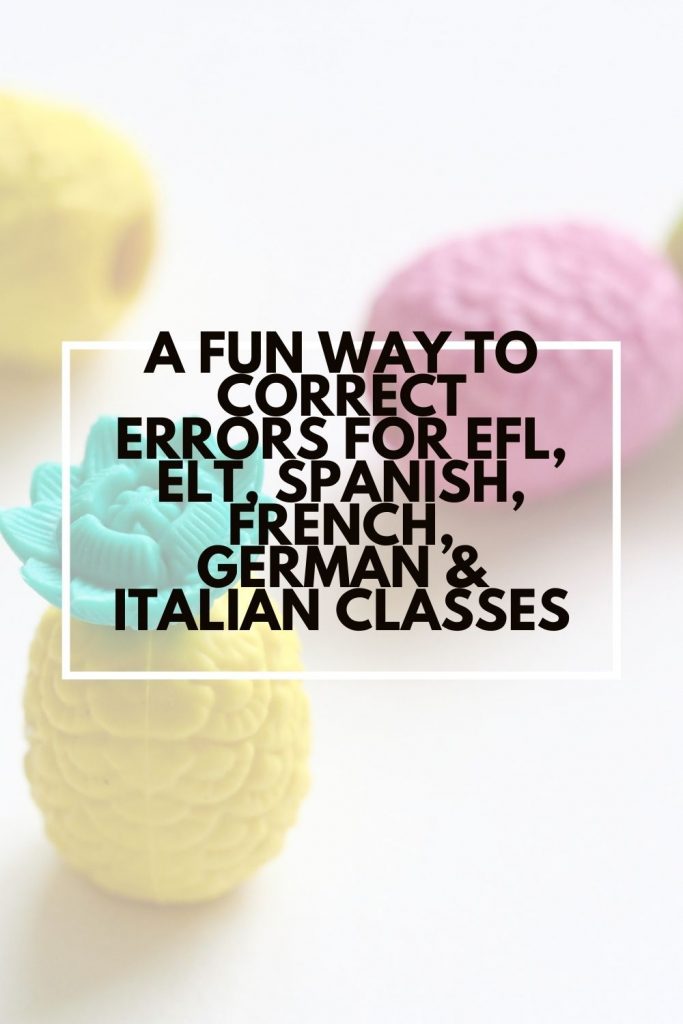I feel really strongly about errors as a language teacher. It’s so interesting, because I think in this profession, we want to be accurate, effective and correct in our communication. And of course, we want that for our students. The instinct sometimes can be to correct everything that’s wrong. We think if we correct an error, then we know what’s wrong. And that’s true. That said, it’s not particularly helpful. Here is one of my favorite activities for French, ELT and Spanish classes. I can’t wait to try it as an Italian and German learner, too.
If you think about it, we communicate more with fluency and more effectively with being able to say more things than we do without necessarily being able to say things more accurately in many cases. We’re dealing with two things here. We want to teach students what’s right, and we want for ourselves to know what is correct and what isn’t correct. That’s important. But we also want to be able to help students keep working on fluency so they can communicate more effectively, and they’re not going to do that without errors. It’s not realistic. If you tell someone you’re not going to speak this new language until you don’t make any errors, it’s probably not ever going to happen. You’re just going to have to accept errors as part of the deal. Errors are okay. We have to teach students how to take risks, allow them to take risks, and allow them to make mistakes. They’re going to need that during all their practice. And as we know, practice makes perfect.
There’s all different sorts of theories on what we should do to correct errors. I think a lot of us repeat back and forth and back to students what they’ve said without explicit corrections. Some people correct absolutely everything, stopping them mid-sentence. There’s so many different ways that people do this.
I’m a proficiency-oriented teacher. Early in my career when I was working in ELT, the practical side of it all became a real focus. I love to teach my students fluency. And again, I have to accept some of these errors. But I can’t accept all of them. I can’t let all of them go.
One activity I really like to do is make error correction a game. I take an assignment- it can be a journal entry, it can be an essay, it can be a letter- any type of writing or speaking that students do.
Take a whole bunch of their errors out, and write them out in some type of format so that they’re not going to recognize the handwriting (really important). If it’s speaking, you want to write them down or say them yourself and record them. It’s really important that they have no idea who it came from. There’s no giveaways. Type them out, or hand write them, and give them back to the students. You might want to put this down in the form of a worksheet, but one way I really like to do it is to display them somehow on the board and only let them see one at a time.
The students try to make the error correct. A lot of times, students will recognize that it’s theirs. If you have an atmosphere of risk taking in the classroom, they wont mind this. It might bother them the first time they see it, but it won’t in the future because they’ll have fun doing this. I usually let the students decide what reward they will get for a correct correction- maybe some points or play Euros. After the error, they’re going to write down what they think is the correct sentence. Of course, you give them however much time you think they need. For the beginners, these sentences are going to be shorter than for the more advanced ones. You know your students, so you know how this needs to go. You’re going to then make the correction for them, and they either get their point, their check, their Euros (maybe dollars or pounds in ELT) whatever it is that they’re getting, or they don’t. You might want to start them off with a little quantity of points or numbers or play euros, something fun that you get to incorporate and recycle numbers. For ELT, I might have something American (where I am from) or British (where I live).
I give you a few examples here so you have the incorrect sentences and then you reveal the correct sentences, or you can correct the sentences in front of them, but I think you get the point. This is a really powerful way to teach grammar in context. You’re not necessarily getting into grammar and structures and you’re not beating grammar to death, but you’re definitely correcting their grammar. They’re all talking about the right and wrong way as well. You’re going to hear them really go back to their thought processes and share their understandings with each other. You’re probably going to see the same patterns of mistakes. You’re going to see some really powerful in-context grammar lessons doing this. Regardless of it is ELT, Spanish, German–we all pass through stages and make the same types of errors in each.
How do you correct errors? How do you deal with them?
Here are some examples from Spanish.
| error | error corregido |
| Mi casa es bonito. | Mi casa es bonita. |
| Tengo diversión. | Me divierto. |
| Yo gusta. | Me gusta. |
| Hace llueve. | Llueve. |
Looking for more activities? Get your free 5 Weeks of Low and No Prep Fun
